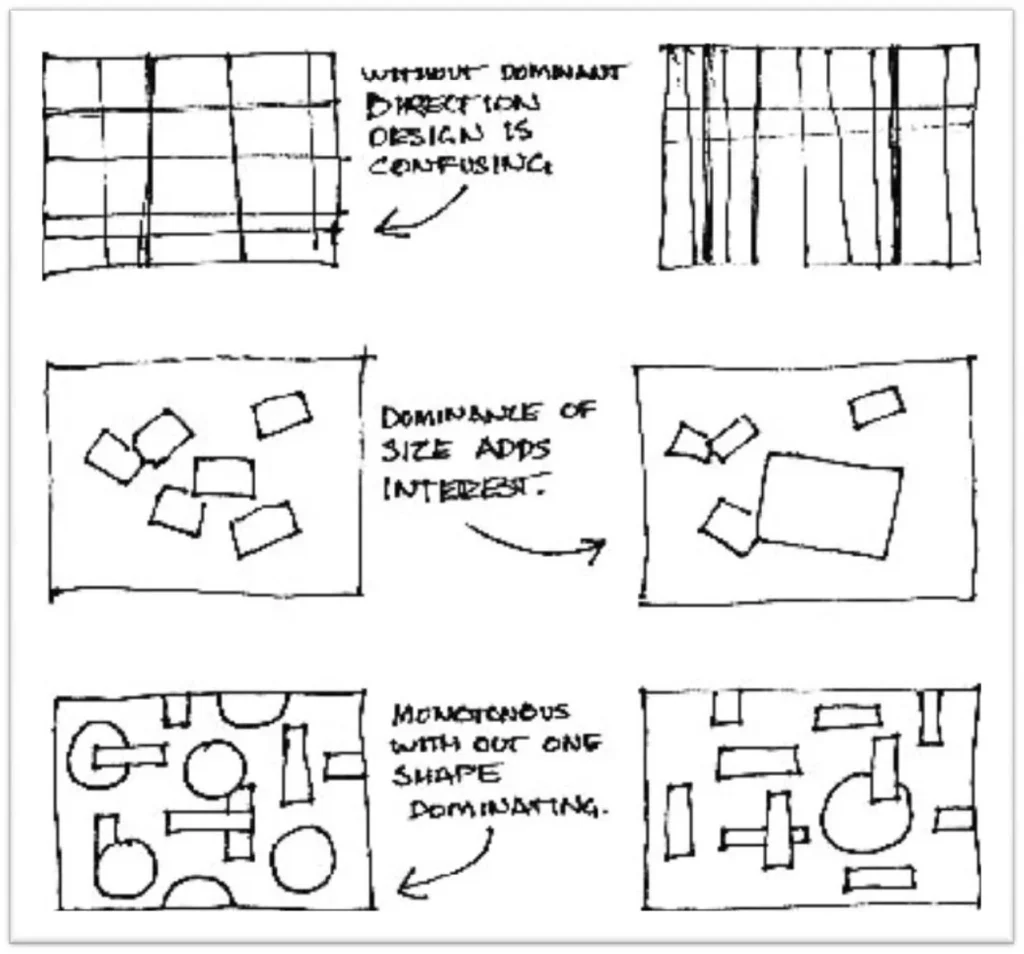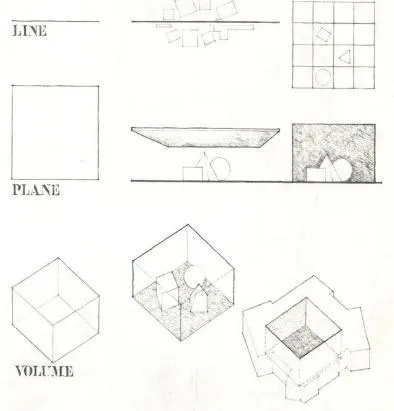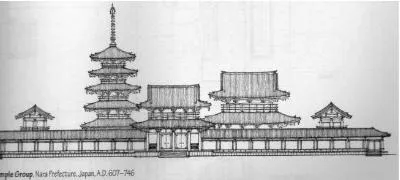If you want to know about the relationship of form and space or form and space in architecture or scale and proportion in architecture, please click the link.
Dominance refers to the visual weight and emphasis of elements in an architectural design, such as buildings, spaces, or objects. It can be achieved through various means such as size, color, texture, or placement, and helps to guide the viewer’s eye and create a sense of hierarchy within the design.
Datum refers to a reference line, plane or point used in architectural design as a basis for measurement and alignment. It serves as a common reference point for design elements and helps to ensure consistency and coherence in the design. Datum is often used in technical drawings and specifications and is a key aspect of the design process in architecture.
1) Dominance
You create dominance through contrast, emphasis and relative visual weight. Your goal is to create elements with noticeable differences in visual weight. Size, Shape, Color, Value, Depth, Texture, Density, Orientation, Perceived physical weight,

- Dominance is something like emphasis but relates to an object or principle.
- Dominance can thus be introduced by having an emphatic object in a composition or by enhancing a design principle.
- Dominance gives a composition interest, counteracting confusion and monotony.

- Dominance refers to a comparison between adjacent objects in terms of relative visual importance.
- Dominant features are superior to all others in visual influence.
- A view may contain more than one dominant feature: Two objects of equal visual influence are said to be co-dominant. Many dominant features in a view tend to be distracting; the eye is drawn from one to another without the opportunity to focus on one major element.
- Dominant features in nature are mountains, a single tall tree among small trees, or any feature that clearly controls the visual scene.
- Skyscrapers and other major man-made objects are dominant if they exert a strong visual attraction over adjacent features

- A dominant direction in the arrangement of lines creates interest and consequently ‘beauty’ in the composition.
- Change of size creates a point of dominance and interest in these compositions. A change by adding a dominating shape creates interest in these compositions.

- Dominance provides a quality to the area within the composition to which the eye is drawn.
- Dominance relates to varying degrees of emphasis in design. It determines the visual weight of a composition, establishes space and perspective, and often resolves where the eye goes first when looking at a design.
- There are three stages of dominance, each relating to the weight of a particular object within a composition.

- Dominant: The object given the most visual weight, the element of primary emphasis that advances to the foreground in the composition.
- Sub-dominant: The element of secondary emphasis, the elements in the middle ground of the composition.
- Subordinate: The object given the least visual weight, the element of tertiary emphasis that recedes to the background of the composition.

- In the example, the trees act as the dominant element, the house and hills as the secondary element, and the mountains as the tertiary element.
2) Datum
- A datum refers to a line, plane, or volume of reference to which other elements in a composition can relate. It organizes a random pattern of elements through its regularity, continuity and constant presence.

- For example, the lines of musical staff serve as a datum in providing the visual basis for reading notes and the relative pitches of their tones.

- The regularity of their spacing and their continuity organizes, clarifies and accentuates the difference between the series of notes in a musical composition.
i) A preceding section illustrated the ability of an axis to organize a series of elements along its length. In effect, the axis was serving as a datum.
ii) A datum, however, need not be a straight line. It can be planner or volumetric in form.
iii) If planner or volumetric in form, datum must have sufficient size colure and regularity to be seen as a figure that can embrace or gather together the elements being organized within fields.

- A line can through or from a common edge for the pattern, while a grid of line can form a natural, unifying field of the pattern.
- A plane can gather the pattern of elements beneath it or serve as an encompassing background for the elements and frame them in its field.
- A volume can collect the pattern of the elements with in its boundaries or organize them a long its perimeter.
Datum is a crucial aspect of architectural design, as it provides a common reference point for measurements and helps ensure consistency and accuracy in the design. Datum is typically established early in the design process and is used throughout the design development and construction phases.
3) Summary
In summary, dominance and datum play important roles in architecture, with dominance shaping the visual impact and hierarchy of design elements, and datum serving as a reference for measurements and alignment. Together, these two concepts help architects and designers create effective, well-designed built environments.
Example
Marin country civic center, San Rafael, California 1957, Frank Lloyd Wright
Haryu-Ji Temple Group, Nara prefecture, Japan, A.D. 607-746
 Marin country civic center, San Rafael, California 1957, Frank Lloyd Wright
Marin country civic center, San Rafael, California 1957, Frank Lloyd Wright
 Haryu-Ji Temple Group, Nara prefecture, Japan, A.D. 607-746
Haryu-Ji Temple Group, Nara prefecture, Japan, A.D. 607-746